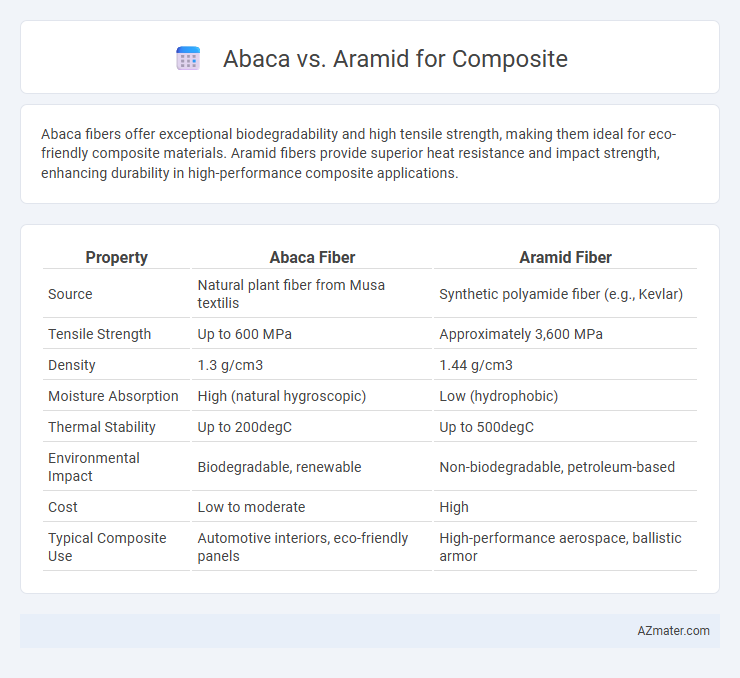Abaca fibers offer exceptional biodegradability and high tensile strength, making them ideal for eco-friendly composite materials. Aramid fibers provide superior heat resistance and impact strength, enhancing durability in high-performance composite applications.
Table of Comparison
| Property | Abaca Fiber | Aramid Fiber |
|---|---|---|
| Source | Natural plant fiber from Musa textilis | Synthetic polyamide fiber (e.g., Kevlar) |
| Tensile Strength | Up to 600 MPa | Approximately 3,600 MPa |
| Density | 1.3 g/cm3 | 1.44 g/cm3 |
| Moisture Absorption | High (natural hygroscopic) | Low (hydrophobic) |
| Thermal Stability | Up to 200degC | Up to 500degC |
| Environmental Impact | Biodegradable, renewable | Non-biodegradable, petroleum-based |
| Cost | Low to moderate | High |
| Typical Composite Use | Automotive interiors, eco-friendly panels | High-performance aerospace, ballistic armor |
Introduction to Abaca and Aramid Fibers
Abaca fiber, derived from the Musa textilis plant native to the Philippines, is known for its exceptional tensile strength, flexibility, and natural resistance to saltwater damage, making it a sustainable choice for composite materials. Aramid fibers, such as Kevlar, are synthetic fibers characterized by high strength-to-weight ratios, extreme heat resistance, and outstanding impact absorption, commonly used in aerospace and ballistic applications. Both fibers offer distinct advantages for composites, with abaca emphasizing eco-friendliness and biodegradability, while aramid provides superior durability and performance under extreme conditions.
Material Origins and Production Processes
Abaca fibers, derived from the Musa textilis plant native to the Philippines, undergo a traditional harvesting and drying process that emphasizes natural extraction and eco-friendly treatment. Aramid fibers, synthetically produced through complex polymerization of aromatic polyamides in highly controlled chemical manufacturing facilities, offer superior tensile strength and heat resistance due to their engineered molecular structure. The bio-based origin of abaca contrasts with the petrochemical-based synthesis of aramid, influencing their respective environmental impacts and performance characteristics in composite materials.
Mechanical Properties Comparison
Abaca fibers exhibit high tensile strength and excellent elongation at break, making them suitable for lightweight composite applications with moderate mechanical demands. Aramid fibers, such as Kevlar, offer superior tensile strength and exceptional impact resistance, providing outstanding durability and stiffness in high-performance composite materials. When comparing mechanical properties, aramid composites outperform abaca in terms of strength-to-weight ratio and fatigue resistance, while abaca provides environmentally friendly and cost-effective reinforcement with adequate mechanical performance for certain structural uses.
Environmental Impact and Sustainability
Abaca fibers, derived from natural banana plants, offer superior biodegradability and lower environmental footprint compared to synthetic aramid fibers, which are petroleum-based and non-biodegradable. The cultivation of abaca supports carbon sequestration and reduces reliance on fossil fuels, contributing to sustainable composite manufacturing. Aramid composites, while offering high strength and thermal resistance, present challenges in recycling and end-of-life disposal, limiting their overall sustainability in eco-conscious applications.
Cost Analysis: Abaca vs Aramid
Abaca fibers offer a cost-effective alternative to aramid fibers in composite manufacturing, with prices generally ranging from $2 to $5 per kilogram compared to aramid's $15 to $30 per kilogram. The lower raw material cost of abaca, coupled with its renewable nature and ease of processing, significantly reduces overall production expenses. Despite aramid's superior mechanical properties, abaca's affordability makes it attractive for applications prioritizing budget without compromising moderate performance.
Performance in Composite Applications
Abaca fibers exhibit low density and high tensile strength, providing excellent impact resistance and biodegradability in composite applications, making them suitable for lightweight, sustainable solutions. Aramid fibers deliver superior tensile strength, exceptional thermal stability, and outstanding resistance to abrasion and fatigue, ideal for high-performance composites requiring durability and safety. When comparing performance, abaca composites favor eco-friendly, cost-effective uses with moderate strength, while aramid composites dominate in demanding structural and protective applications due to their superior mechanical properties.
Durability and Lifespan
Abaca fibers exhibit high resistance to saltwater and abrasion, making them durable in marine and outdoor composite applications, yet they generally have a shorter lifespan compared to synthetic fibers. Aramid fibers, known for exceptional tensile strength and thermal stability, offer superior durability and longer service life in composites exposed to intense mechanical stress and heat. Selecting between abaca and aramid composites depends on balancing natural fiber sustainability with the enhanced durability and extended lifespan of advanced aramid materials.
Weight and Density Considerations
Abaca fibers have a density of approximately 1.5 g/cm3, making them lighter than aramid fibers, which typically have a density around 1.44 g/cm3. Despite aramid's slightly lower density, abaca offers a natural, sustainable alternative with excellent strength-to-weight ratio crucial for lightweight composite applications. Weight-sensitive composite designs benefit from abaca's combination of low density and high tensile strength, optimizing overall structural efficiency.
Industry Use Cases and Trends
Abaca fibers, known for their biodegradability and high tensile strength, are increasingly favored in automotive and marine composites for lightweight and eco-friendly applications, reducing environmental impact. Aramid fibers like Kevlar demonstrate superior thermal resistance and impact absorption, making them essential in aerospace, defense, and ballistic composites where durability and safety are critical. Trends indicate a growing shift toward hybrid composites combining abaca and aramid to achieve balanced performance, sustainability, and cost-efficiency in various industrial sectors.
Future Prospects in Composite Materials
Abaca fibers offer sustainable advantages with high tensile strength, biodegradability, and excellent vibration damping, positioning them as eco-friendly alternatives in composite materials. Aramid fibers, known for their superior heat resistance, exceptional strength-to-weight ratio, and durability, remain essential in advanced aerospace and defense composites. Future prospects lie in hybrid composites combining abaca's sustainability with aramid's performance, driving innovation in lightweight, high-strength, and environmentally conscious materials.

Infographic: Abaca vs Aramid for Composite
 azmater.com
azmater.com